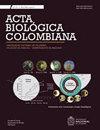哥伦比亚高海拔安第斯热带水库浮游生物生物量动态模拟。
IF 0.4
4区 生物学
Q4 PLANT SCIENCES
引用次数: 0
摘要
对水库中浮游生物群落之间关系的理解使我们能够推断出这些系统中物质和能量流再分配的可能变化。本文提出了Riogrande II热带水库营养网络的动态模型,该模型整合了碎屑和放牧的浮游营养链,并通过引入猎物相遇因子(猎物相遇因子)来限制捕食者与猎物的相互作用。通过广泛的文献检索,我们建立了一个质量平衡的动态模型。消费者和资源的局限性同时通过pmf表现出来。用于验证该模型的数据来自于2010年至2013年在该油藏进行的先前调查。我们在每个模拟中发现的pmf值表明,在一定浓度的总磷浓度下,顶级捕食者可以接近其主要猎物,遇到的概率在9.3%到17.7%之间。我们的模拟表明,大部分初级产品在光区被初级消费者利用得很差,然而,它进入碎屑链的流动,并几乎完全支持浮游动物的生产。根据这一发现,用该模型假设的因果关系可以更好地解释以往研究中得到的生物量密度。本文章由计算机程序翻译,如有差异,请以英文原文为准。
SIMULATION OF BIOMASS DYNAMICS IN PLANKTON OF A HIGH-ALTITUDE ANDEAN TROPICAL RESERVOIR IN COLOMBIA.
The understanding of the relationships between the planktonic communities in a reservoir allows us to infer possible changes in the redistribution of matter and energy flows in these systems. This work proposes a dynamic model for the trophic network of the Riogrande II tropical reservoir, which integrates the planktonic trophic chains of detritus and grazing, limiting the prey-predator interactions by introducing the prey meeting factor (pmf). We built a dynamic model of mass balance supported by an extensive bibliographic search. The limitations of consumers and resources were represented simultaneously by means of the pmf. The data used to validate the model were compiled from previous investigations carried out in this reservoir from 2010 to 2013. The values of pmf that we found in each simulation suggest that the top predator can access its main prey in certain concentrations of total phosphorus, with a probability of encounter ranging from 9.3 % to 17.7 %. Our simulations indicate that most of the primary production is poorly used by the primary consumers in the photic zone, however, it enters in the flows of the detrital chain and supports the production of zooplankton almost entirely. According to this finding, the biomass densities obtained in the previous studies can be better explained by the causal relationships assumed in this model.
求助全文
通过发布文献求助,成功后即可免费获取论文全文。
去求助
来源期刊

Acta Biologica Colombiana
Agricultural and Biological Sciences-General Agricultural and Biological Sciences
CiteScore
1.60
自引率
0.00%
发文量
21
审稿时长
13 weeks
期刊介绍:
The journal is published quarterly and divulges original and unpublished results of basic and applied research about biological subjects with special interest in Neotropical region. Manuscripts may be research articles, reviews, reflection articles or short notes. The Acta biol. Colomb Journal have a scientific and editorial board composed of expert researchers of in their areas of knowledge.
 求助内容:
求助内容: 应助结果提醒方式:
应助结果提醒方式:


